Treatment of olive mill wastewater through employing sequencing batch reactor: performance and microbial diversity assessment
- PMID: 30456015
- PMCID: PMC6233312
- DOI: 10.1007/s13205-018-1486-6
Treatment of olive mill wastewater through employing sequencing batch reactor: performance and microbial diversity assessment
Abstract
This work describes the performance of a sequencing batch reactor (SBR) and the involvement of a novel reconstituted bacterial consortium in olive mill wastewater (OMW) treatment. The organic loading rate applied to the SBR was serially increased in terms of initial COD from 10 to 75 g L-1 to allow gradual acclimatization of activated sludge to high concentrations of toxic compounds in OMW. After the acclimatization period, up to 60% of the total COD content were effectively biodegraded from OMW at 75 g L-1 COD within 30 day hydraulic retention time. The diversity and community composition of cultivable bacteria participating in the aerobic process of treating OMW were further assessed. A total of 91 bacterial strains were isolated from the reactor and analyzed by amplification of the 16S-23S rRNA internal transcribed spacer (ITS) region and by 16S rRNA gene sequencing. The most abundant phylum was Firmicutes (57.1%) followed by Proteobacteria (35.2%) and Actinobacteria (7.7%). The use of the Biolog® Phenotype Microarray system to evaluate the ability of isolated strains to utilize OMW phenolic compounds is reported in this work for the first time. Interestingly, results showed that all species tested were able to utilize phenolics as sole carbon and energy sources. The removals of COD and phenolics from undiluted OMW by the reconstituted bacterial consortium were almost similar to those obtained by the acclimatized activated sludge, which suggest that cultivable bacteria play the major role in OMW biodegradation. Phytotoxicity assays using tomato seeds showed a significant improvement of seed germination values for treated OMW. Our overall results suggest that the novel developed bacterial consortium could be considered as a good prospect for phenolics-rich wastewaters bioremediation applications.
Keywords: Acclimatized aerobic consortium; Biolog ® phenotyping; Olive mill wastewater; Phenolic compounds; Phytotoxicity; Sequencing batch reactor.
Conflict of interest statement
Compliance with ethical standardsThe authors declare that they have no conflicts of interest.
Figures





References
-
- AFNOR (1983) Recueil de norme française: eau, méthodes d’essai, 2éme édition, Paris
-
- Aggelis G, Iconomou D, Christou M, Bokas D, Kotzailias S, Christou G, Tsagou V, Papanikolaou S. Phenolic removal in a model olive oil mill wastewater using Pleurotusostreatus in bioreactor cultures and biological evaluation of the process. Water Res. 2003;37:3897–3904. doi: 10.1016/S0043-1354(03)00313-0. - DOI - PubMed
-
- Aissam H, Penninckx MJ, Benlemlih M. Reduction of phenolics content and COD in olive oil mill wastewaters by indigenous yeasts and fungi. World J Microb Biot. 2007;23:1203–1208. doi: 10.1007/s11274-007-9348-0. - DOI
LinkOut - more resources
Full Text Sources

